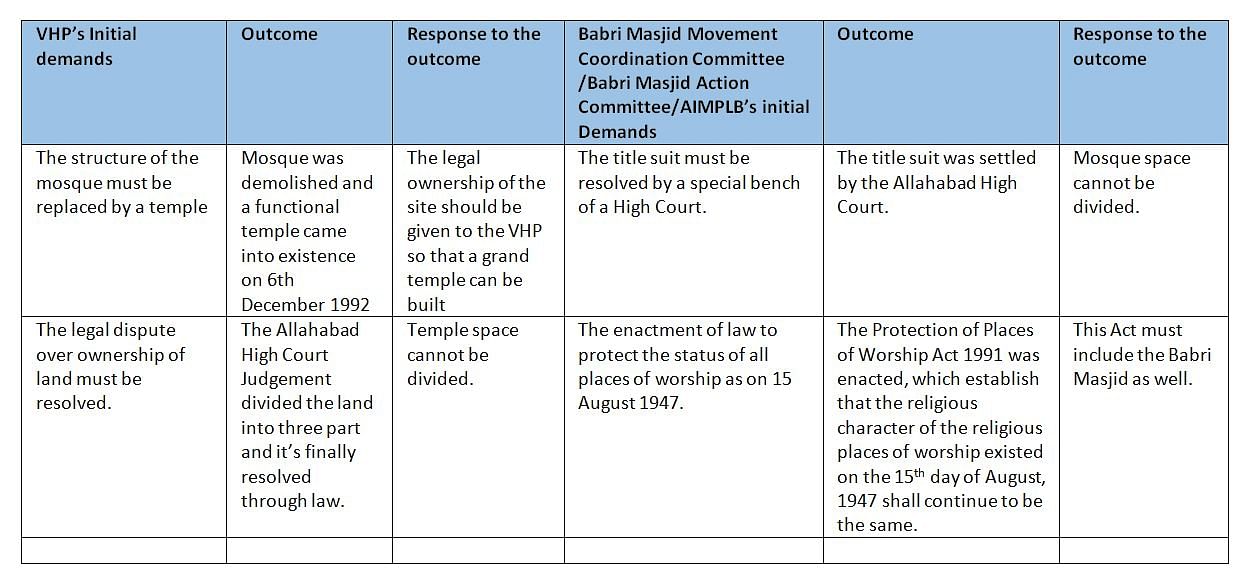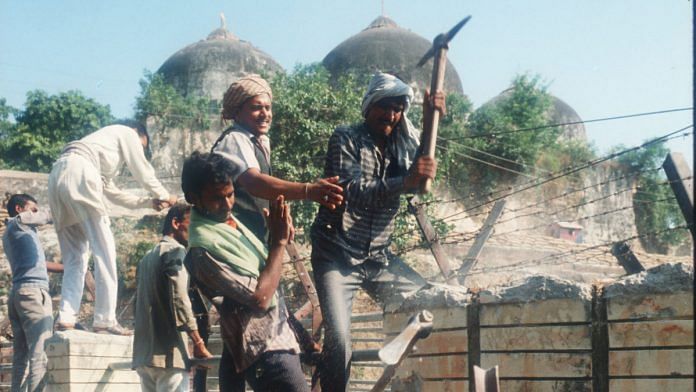Muslim political groups begin to treat Babri Masjid case as a non-political ‘legal’ battle after its demolition in 1992.
The dominant political rhetoric around the Ayodhya dispute portrays Muslims either as victims — whose mosque was demolished by a Hindutva mob in 1992, or as determined contenders — who will not give up even the site of a demolished mosque for the construction of a Ram Mandir.
This reductive representation of Muslims as a homogeneous political entity does not allow us to look at the complex role played by Muslim politicians in the Ayodhya case.
The Babri Masjid case was not just a simple Hindu-Muslim conflict. It was actually an outcome of a complex legal battle between various local stakeholders.
Two questions must be asked: How did the Babri Masjid become a national Muslim issue? And, why did Muslim political groups begin to treat the Babri Masjid case as a non-political ‘legal’ battle after its demolition in1992?
Also read: Why Ayodhya cannot be resolved like Somnath temple
Babri Masjid — a local issue of Ayodhya
Muslim politics on Babri Masjid actually began only in 1984. Although the mosque was forcibly occupied by a Hindu mob in December 1949 and subsequently taken over by the district administration, it became a national level Hindu-Muslim conflict only in the early 1980s.
In 1983, the Vishwa Hindu Parishad (VHP) established a Dharmasthan Mukti Yagna Samiti and launched its nation-wide agitation to ‘liberate’ sacred Hindu religious places. Within a year, it started focusing on the Babri Masjid case and formed the Sri Ram Janmabhoomi Mukti Yagna Samiti. To further intensify this campaign, a Rath Yatra from Ayodhya to Lucknow was organised in 1984, which was followed by a signature campaign.

In reaction, some local Muslims of Faizabad formed the Babri Masjid Action Committee (BMAC) under the leadership of a Muslim lawyer, Yunus Siddiquie in October 1984. Based on my interview with Siddiquie for my book, there were two objectives of this Committee: (a) to solve the dispute through legal action and, (b) to protect the long-term interests, life and property of the Muslim community of Faizabad and Ayodhya.
The national-level Muslim leaders did not show any interest in the BMAC. Neither the Imam of Delhi’s Jama Masjid, Abdullah Bukhari (who played a significant role in the Shah Bano agitation) nor the bureaucrat-turned-politician Syed Shahabuddin (who published several news items in his journal Muslim India on the Babri Masjid case) established any contact with the BMAC in the period 1984-86.
Babri Masjid – a national Muslim issue
The Babri Masjid was opened for Hindu worshippers on 1 February 1986 by then Prime Minister Rajiv Gandhi. Only after this, the Muslim elite began to recognise the potential of this conflict.
It forced three different Muslim political forces – the All India Muslim Majlis-e-Mushawarat (AIMMM), a network of Muslim organisations established in 1964, the radical Muslim leaders, especially from UP led by the Imam Bukhari, and the Ulema of the All India Muslim Personal Law Board (AIMPLB) – to come together and form a coalition of some kind.
Also read: BJP will hand Ayodhya victim card to every Hindu voter ahead of 2019 elections
This led to the formation of the national-level Muslim coalition in 1986 known as the Babri Masjid Movement Coordination Committee (BMMCC). This political alignment played a very crucial role in defining the status of Babri Masjid. The ‘Declaration of Delhi’, which was adopted by this coalition on 22 December 1986, defines the Babri Masjid as a part of India’s national heritage and linked it to the rights of religious minorities. It says:
The Conference regards the Babri Masjid as a national heritage and as a historical monument but, above all, as a place of Islamic worship whose sanctity must be universally respected by all right minded persons, whatever their religion and whose violation should be regarded as an offence to the religious sentiments of the Muslims but also to the secular order because it contravenes Article 25 of the Constitution. (Muslim India, Vol. 50, 1987 pp. 59-60, 64)
Babri Masjid—from the political to the legal
The Muslim coalition disintegrated in 1988 when the group led by the Imam formed a new Babri Masjid Action Committee. This development, however, did not affect the defined status of Babri Masjid as a national heritage-cum-mosque.
In fact, they adopted a twofold strategy.
For mobilising Muslims, the ‘restoration of mosque’ was defined as a demand to allow namaz inside the Babri Masjid by removing the idols – and restoring it to its pre-1949 status as a functional mosque.
On the other hand, in all the published documents and declarations, ‘restoration of Babri Masjid’ is described in terms of the protection of historic Islamic monuments as national heritage.
This strategy helped the Muslim elites successfully achieve two main objectives – bring a new central law for the Protection of the Religious Places of Worship (Special Provisions) Act 1991; and transfer the Ayodhya title case to a special bench of High Court, even before the demolition of the Babri Masjid on 6 December 1992.
This was precisely the reason why a new realignment began in 1993. All Muslim parties and groups decided to recognise the AIMPLB’s High Power Committee as the core body to look after the legal case on Babri Masjid. The Imam-led Action Committee passed a resolution on 1 December 1993 to suspend all the agitational programmes:
….Since the Committee had decided on 26 January 1993 to suspend agitational program for some time and to cooperate with the AIMPLB…In order to maintain the unity of Millat [the community], we do not consider it proper to announce a protest programme for the present. (Muslim India, 134 February, 1994, p. 62)
The common Muslims, who were mobilised in the name of protecting the mosque, were always told that Babri Masjid was a political defeat for them. Even the legal achievements were never celebrated by the Muslim elite simply to keep the issue alive.
Also read: Explained: All things Babri, Faruqui and Ayodhya
The Ayodhya dispute, in other words, is not entirely imposed on common Muslims by Hindutva politics; the contribution of the Muslim elite is also significant.
Hilal Ahmed is a scholar of political Islam and associate professor at Centre for the Study of Developing Societies.
This is a two-part series on Ayodhya by the author.




It may have taken different strands of the Muslim community time to coalesce on this issue. However, they all recognised the sentiment – and the menace – that lay at the heart of some sections of the majority community laying claim to a 450 year old mosque. Nor are the claims – shrouded in the mists of medieval history – restricted to Ayodhya; Mathura is n3xt, and next door. 2. One cannot predict how the apex court will rule on this issue. Hopefully the matter will be disposed of after the general election. Suppose, for the sake of the argument, it decides the title suit in favour of the Hindu comm7nity. Will that cleanse and sanitise what was done on the site 26 years ago ? 3. For the Muslim community, the fight is not over a mosque that may have fallen into disuse over half a century ago. Nor is it about a few acres of land that would have been worth a pittance if it had not been imbued with religious significance. They see all that happened on the road to demolition of the Babri mosque and thereafter as an assault on the equality before law and right to life and liberty granted to all citizens as being under existential threat. They fear a majoritarian India where they are children of a lesser God, condemned to live in fear and subordinate status. I am certain their legitimate concerns are understood and shared by most Hindus as well.